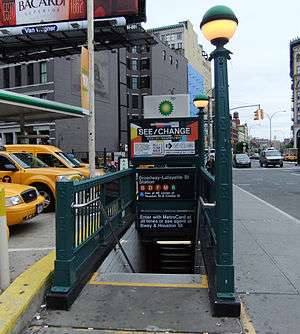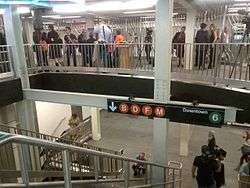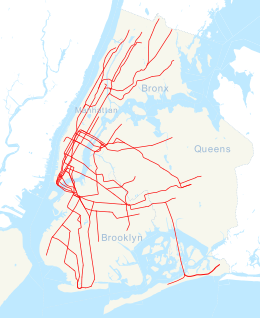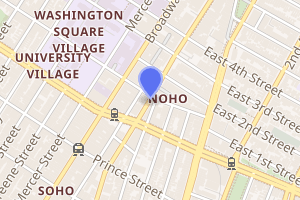Broadway–Lafayette Street/Bleecker Street station
Broadway–Lafayette Street/Bleecker Street is a New York City Subway station complex in the NoHo district of Manhattan on the IRT Lexington Avenue Line and the IND Sixth Avenue Line. It is served by the:
- 6, D, and F trains at all times
- B and M trains on weekdays
- <6> and <F> trains during rush hours in the peak direction
- 4 train during late nights
Broadway–Lafayette Street/ Bleecker Street | |||||||||||||||
|---|---|---|---|---|---|---|---|---|---|---|---|---|---|---|---|
 One of the two street stairs along the south side of East Houston Street between Broadway and Crosby Street | |||||||||||||||
| Station statistics | |||||||||||||||
| Address | Bleecker Street & Lafayette Street New York, NY 10012 | ||||||||||||||
| Borough | Manhattan | ||||||||||||||
| Locale | NoHo, SoHo, Greenwich Village | ||||||||||||||
| Coordinates | 40°43′33″N 73°59′41″W | ||||||||||||||
| Division | A (IRT), B (IND) | ||||||||||||||
| Line | IND Sixth Avenue Line IRT Lexington Avenue Line | ||||||||||||||
| Services | 4 6 B D F M | ||||||||||||||
| Transit connections | |||||||||||||||
| Other information | |||||||||||||||
| Opened | May 19, 1957 (IND–southbound IRT) September 25, 2012 (IND–northbound IRT) | ||||||||||||||
| Station code | 619[1] | ||||||||||||||
| Accessible | |||||||||||||||
| Wireless service | |||||||||||||||
| Traffic | |||||||||||||||
| Passengers (2019) | 12,455,155[3] | ||||||||||||||
| Rank | 22 out of 424[3] | ||||||||||||||
| |||||||||||||||
| |||||||||||||||
| |||||||||||||||
The complex comprises two stations, Bleecker Street (IRT) and Broadway–Lafayette Street (IND). The transfer between the downtown IRT platform and the IND platform has been within fare control since May 19, 1957, and the corresponding free transfer from the uptown IRT platform to the rest of the station opened on September 25, 2012.
Station layout
| G | Street level | Exits/entrances |
| B1 | East mezzanine | Fare control, exits to east side of Lafayette Street |
| Side platform | ||
| Northbound local | ← ← | |
| Northbound express | ← | |
| Southbound express | | |
| Southbound local | | |
| Side platform | ||
| West mezzanine | Fare control, station agent, exits to Houston Street and west side of Lafayette Street | |
| B2 | Mezzanine | Transfer between platforms |
| B3 | Northbound local | ← ← |
| Island platform | ||
| Northbound express | ← ← | |
| Southbound express | | |
| Island platform | ||
| Southbound local | | |

This station had a unique feature in the system in that a transfer to the IND platforms from the IRT station was only possible in the southbound direction until late September 2012.[4] A free transfer passageway from the downtown IRT platform to the IND platform opened on May 19, 1957 after the IRT station's platforms were lengthened by two cars to accommodate 10-car trains.[5][6] This "one-way" transfer existed for 55 years, as the connection from the IND platforms to the downtown IRT platform was purely coincidental, and was not originally intended when first built.[6] The construction of a connection from the northbound platform would have required more extensive construction, including knocking down support walls and digging a tunnel. The northbound platform was extended two car lengths to the north because it was easier to do and cost less.[7] As a result, a free transfer was not available to the northbound platform and access to it required a one-block walk north to Bleecker Street and payment of an additional fare except to Unlimited-Ride MetroCard holders.[8]
A transfer between the IND platforms and the uptown IRT platform had been planned since 1989, with its inclusion in the Metropolitan Transportation Authority (MTA)'s Third Capital Program.[8] Construction on the transfer would have started in 1992 pending the approval of the program by the State Legislature. The MTA estimated that 15,000 daily passengers would use the free transfer.[7] However, it was not built until the MTA's 2005–2009 capital program allocated $50 million to renovate the complex, which included installation of ADA-accessible elevators and a free transfer to the uptown IRT platform. Prior to the reconstruction, the Broadway–Lafayette Street station connected only to the southbound platform of Bleecker Street at the extreme south end.[4] On March 26, 2012, the uptown platform was shifted 300 feet (91 m) south to the newly constructed extension and the 1950s northern extension closed at the same time. On the same day, the MTA had stated that the transfer project to the uptown Bleecker Street platform would be completed at the end of June.
The uptown transfer did not fully open until September 25, 2012. The overall cost of the rehabilitation project had climbed to US$135 million.[9] On the same day, an escalator connected the uptown platform of the Broadway-Lafayette Street station with a new transfer mezzanine that connected riders to the uptown platform of the Bleecker Street station. In addition, elevators were installed to connect the various platforms of the IND station, and those of Bleecker Street.[10][11][12] The transfer boasted new elevators and escalators to the IND station below. The street-level elevator accesses the southbound IRT platform directly, while four other elevators in the station connect each IND platform with each IRT platform.[13]
Entrances and exits
The station has a total of 12 staircase entrances and 1 elevator entrance.[14]
| Exit location[14] | Exit type | Number of exits | Platforms primarily served |
|---|---|---|---|
| NE corner of Broadway and Houston Street | Staircase | 1 | Sixth Avenue Line |
| SE corner of Broadway and Houston Street | Staircase | 1 | Sixth Avenue Line |
| NW corner of Houston Street and Lafayette Street | Staircase | 1 | Sixth Avenue Line Lexington Avenue Line southbound |
| Elevator | 1 | ||
| SW corner of Houston Street and Lafayette Street | Staircase | 2 | Sixth Avenue Line Lexington Avenue Line southbound |
| NE corner of Houston Street and Lafayette Street | Staircase | 1 | Sixth Avenue Line Lexington Avenue Line northbound |
| SE corner of Houston Street and Lafayette Street | Staircase | 1 | Sixth Avenue Line Lexington Avenue Line northbound |
| NW corner of Bleecker Street and Lafayette Street | Staircase | 1 | Lexington Avenue Line southbound |
| SW corner of Bleecker Street and Lafayette Street | Staircase | 1 | Lexington Avenue Line southbound |
| NE corner of Bleecker Street and Lafayette Street | Staircase | 1 | Lexington Avenue Line northbound |
| SE corner of Bleecker Street and Lafayette Street | Staircase | 1 | Lexington Avenue Line northbound |
| Corner of Bleecker Street and Mulberry Street | Staircase | 1 | Lexington Avenue Line northbound |
In addition, there are closed stairs to both western corners of Broadway and Houston Street.
Gallery
 An entrance to the northbound IRT platform in 2010, before the opening of the free transfer
An entrance to the northbound IRT platform in 2010, before the opening of the free transfer The same entrance after the opening of the free transfer
The same entrance after the opening of the free transfer The Hive artwork by Leo Villareal
The Hive artwork by Leo Villareal The new transfer to the northbound IRT platform; the IND platforms are below
The new transfer to the northbound IRT platform; the IND platforms are below
IRT Lexington Avenue Line platforms
Bleecker Street | |||||||||||||
|---|---|---|---|---|---|---|---|---|---|---|---|---|---|
Platform for the uptown local 6 train | |||||||||||||
| Station statistics | |||||||||||||
| Division | A (IRT) | ||||||||||||
| Line | IRT Lexington Avenue Line | ||||||||||||
| Services | 4 6 | ||||||||||||
| Structure | Underground | ||||||||||||
| Platforms | 2 side platforms | ||||||||||||
| Tracks | 4 | ||||||||||||
| Other information | |||||||||||||
| Opened | October 27, 1904[15] | ||||||||||||
| Station code | 408[1] | ||||||||||||
| Accessible | |||||||||||||
| Wireless service | |||||||||||||
| Opposite-direction transfer available | Yes | ||||||||||||
| Station succession | |||||||||||||
| Next north | Astor Place: 4 | ||||||||||||
| Next | 23rd Street: 4 | ||||||||||||
| Next south | Spring Street: 4 | ||||||||||||
| Next | Canal Street: 4 | ||||||||||||
| |||||||||||||
Bleecker Street Subway Station (IRT) | |||||||||||||
New York City Landmark No. 1096 | |||||||||||||
| MPS | New York City Subway System MPS | ||||||||||||
| NRHP reference No. | 04001012[16] | ||||||||||||
| NYCL No. | 1096 | ||||||||||||
| Significant dates | |||||||||||||
| Added to NRHP | September 17, 2004 | ||||||||||||
| Designated NYCL | November 24, 1981[17] | ||||||||||||
Bleecker Street on the IRT Lexington Avenue Line is a standard local station with four tracks and two side platforms.
This station was opened on October 27, 1904, as part of the original subway.[18][19] Fare control is currently at platform level, with a crossunder via the IND platforms. It has two side platforms which were originally 5-cars long. In the 1950s, the southbound platform was extended to the south and the northbound platform was extended to the north for ten car trains. After the 2012 renovation, the northbound platform was extended to the south, and the 1950s northern extension of that platform was closed (but can still be seen upon leaving the station on a train).[9]
The station features two styles of "Bleecker Street" station identifiers made by the Grueby Faience Company in 1904. The large "Bleecker Street" plaques were assembled from 27 pieces of faience ceramic. They depict poppies. The smaller blue "B" cartouches show tulips, probably a reminder of the Dutch origins of the city. Later Vickers' mosaic tablets were installed when the station was extended, and five different colors were used for the mosaics. These mosaics were removed in the 2012 renovation of the station, and replicas of the "B" cartouches were installed throughout the station.
A new MTA's Arts for Transit project was created in 2012, called Hive, by Leo Villareal. It is located at the newest section of the uptown platform in the mezzanine providing the transfer to the IND station.[20] This new art complements the first work—Signal by Mel Chin, which was added to the station complex in 1997.
Gallery
- Faience name tablet, Heins & LaFarge/Grueby Faience Company, from 1904
- Original cartouche
 Pre-renovation Mosaic station tablets by Vickers
Pre-renovation Mosaic station tablets by Vickers- Southbound stairway at street
 The station used to have skylights to let in natural light (1905)
The station used to have skylights to let in natural light (1905)
IND Sixth Avenue Line platforms
Broadway–Lafayette Street | |||||||||||||
|---|---|---|---|---|---|---|---|---|---|---|---|---|---|
| Station statistics | |||||||||||||
| Division | B (IND) | ||||||||||||
| Line | IND Sixth Avenue Line | ||||||||||||
| Services | B D F M | ||||||||||||
| Structure | Underground | ||||||||||||
| Platforms | 2 island platforms cross-platform interchange | ||||||||||||
| Tracks | 4 | ||||||||||||
| Other information | |||||||||||||
| Opened | January 1, 1936 | ||||||||||||
| Station code | 230[1] | ||||||||||||
| Accessible | |||||||||||||
| Wireless service | |||||||||||||
| Opposite-direction transfer available | Yes | ||||||||||||
| Station succession | |||||||||||||
| Next west | West Fourth Street–Washington Square: B | ||||||||||||
| Next | West Fourth Street–Washington Square: B | ||||||||||||
| Next east | Second Avenue (local): F Grand Street (express): B Essex Street (local via Chyrstie St.): M | ||||||||||||
| Next | Jay Street–MetroTech (local): F DeKalb Avenue (express via Chrystie St.): B Atlantic Avenue–Barclays Center (express via Chrystie St.): D Marcy Avenue (local via Chrystie St.): M | ||||||||||||
| |||||||||||||
Broadway–Lafayette Street on the IND Sixth Avenue Line is an express station, located on East Houston Street between Broadway and Lafayette Street in Manhattan. This section of the station complex, opened on January 1, 1936, has four tracks and two island platforms.[21] B and D trains stop on the inner express tracks while F and M trains stop on the outer local tracks.[21] Both outer track walls have a blue trim line on a black border and small "BROADWAY" signs beneath in white lettering on a black border. Large blue columns run along either side of both platforms at regular intervals with alternating ones having the standard black station name plate and white lettering.
The center of both platforms have three staircases that go up to a mezzanine, where wide staircases on either side go up to the station's three fare control areas. The full-time side is at the west end (railroad north). It has a turnstile bank, token booth, and two staircases going up to either eastern corners of Broadway and East Houston Street. The southeastern one is built inside an alcove of an Adidas Sport Performance Center.[22] The station's other fare control areas lead to exits on either side of East Houston Street. In one fare control area, a set of full height turnstiles lead to two separate entrances leading to East Houston Street between Lafayette and Crosby Streets, on the south side. In the other fare control area, another set of full height turnstiles leads to another entrance on Lafayette Street and Houston Street, on the north side. A passageway connects the Lafayette Street fare control areas with the fare control areas at the Broadway end of the station without going through the lower level mezzanine.
There are closed staircases from the extreme western ends of both platforms that lead to a mezzanine with exits to the west side of Broadway and Houston Street. It is currently used by employees.
The 1998 artwork here is called Signal by Mel Chin. It features stainless steel and glass sculptures with lights on the mezzanine walls and ceramic tiles on the platform walls.
West (railroad north) of this station, there are crossovers between the two northbound tracks and a single one between the express tracks. The line turns north along Sixth Avenue and goes through a complex set of switches and crossovers with the IND Eighth Avenue Line before arriving at West Fourth Street–Washington Square.
East (railroad south) of this station, there used to be a crossover between the two southbound tracks before they were reconfigured in 1967 by the Chrystie Street Connection. B and D trains turn south down Chrystie Street with a stop at Grand Street before crossing the Manhattan Bridge into Brooklyn. F trains continue directly east with a stop at Second Avenue, turn south on Essex Street with two more stops at Delancey Street and East Broadway, before passing under the East River through the Rutgers Street Tunnel into Brooklyn. M trains use a connection that leads to Essex Street on the BMT Nassau Street Line before crossing the Williamsburg Bridge into Brooklyn.
References
- "Station Developers' Information". Metropolitan Transportation Authority. Retrieved June 13, 2017.
- "NYC Subway Wireless – Active Stations". Transit Wireless Wifi. Retrieved November 13, 2019.
- "Facts and Figures: Annual Subway Ridership 2014–2019". Metropolitan Transportation Authority. 2020. Retrieved May 26, 2020.
- With connection to No 6 line, a Manhattan transfer is coming New York Times Retrieved August 2, 2006
- "Passage Links Subways" (PDF). Retrieved October 10, 2016.
- Chan, Sewell (May 7, 2005). "With Connection on No. 6 Line, a Manhattan Transfer Is Coming". The New York Times. Retrieved April 27, 2011.
- "Only In New York: The Newsletter of the New York City Transit Authority". New York City Transit Authority. 1990. Retrieved April 7, 2019 – via Flickr.
- The New York Transit Authority in the 1980s
- "Bleecker Street Platform Shifts". MTA.info. March 26, 2012. Retrieved March 27, 2012.
- Redwine, Tina (September 25, 2012). "Transfers At Bleecker Street Are No Longer A Bleak Situation". NY1. Archived from the original on January 30, 2013. Retrieved September 26, 2012.
- Matt Flegenheimer (September 24, 2012). "A Vexing Flaw in the Subway Is Finally Fixed". New York Times. pp. A18–A19. Retrieved September 28, 2012.
- "Archived copy". Archived from the original on August 13, 2016. Retrieved October 28, 2015.CS1 maint: archived copy as title (link)
- "Bleecker Street Platform Shifts". MTA.info. March 26, 2012. Retrieved March 27, 2012.
-
- "MTA Neighborhood Maps: East Village" (PDF). mta.info. Metropolitan Transportation Authority. 2015. Retrieved August 19, 2015.
- "MTA Neighborhood Maps: SoHo / Tribeca" (PDF). Metropolitan Transportation Authority. 2015. Retrieved August 6, 2015.
- "Our Subway Open: 150,000 Try It; Mayor McClellan Runs the First Official Train". The New York Times. October 28, 1904. p. 1. ISSN 0362-4331. Retrieved April 21, 2020.
- "NPS Focus". National Register of Historic Places. National Park Service. Retrieved December 24, 2011.
- "Interborough Rapid Transit System, Underground Interior" (PDF). New York City Landmarks Preservation Commission. November 24, 1981. Retrieved November 19, 2019.
- "New York City subway opens - Oct 27, 1904". HISTORY.com. October 27, 1904. Retrieved May 11, 2016.
- James Blaine Walker, Fifty Years of Rapid Transit, 1864-1917, published 1918, pp. 162-191
- Redwine, Tina (July 21, 2012). "MTA Unveils Digital Art At Bleecker Street Station". NY1. Archived from the original on July 24, 2012. Retrieved July 22, 2012.
- Broadway-Lafayette Street NYCSubway Retrieved August 28, 2008
- Downtown Bleecker Street/Broadway–Lafayette Street On NY Turf Retrieved August 28, 2008 Archived July 17, 2011, at the Wayback Machine
External links
| External video | |
|---|---|
![]()
- Forgotten NY – Original 28 - NYC's First 28 Subway Stations
nycsubway.org
- nycsubway.org – IRT East Side Line: Bleecker Street
- nycsubway.org – IND 6th Avenue: Broadway/Lafayette
- nycsubway.org – Signal Artwork by Mel Chin (1998)
Station Reporter
MTA's Arts For Transit
Google Maps Street View




.jpg)

